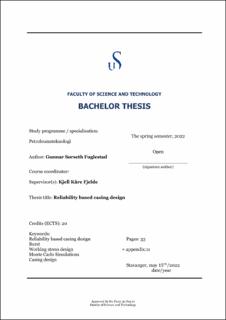| dc.contributor.advisor | Fjelde, Kjell | |
| dc.contributor.author | Fuglestad, Gunnar | |
| dc.date.accessioned | 2022-07-13T15:51:50Z | |
| dc.date.available | 2022-07-13T15:51:50Z | |
| dc.date.issued | 2022 | |
| dc.identifier | no.uis:inspera:108212691:50087507 | |
| dc.identifier.uri | https://hdl.handle.net/11250/3005148 | |
| dc.description.abstract | Working stress design is today the most used method for casing design. This method is easy to learn and uses enough safety factors to provide a safe design. Reliability based design is a stochastic approach to casing design that adds another layer of complexity. The reliability based design method applies safety factors for specific parameters from the case study. This helps us visualize the different safety factors and where the safety factors are applied rather than taking the safety factors for granted. The reliability based design method calculates a probability of failure that determines whether the selected casing meets the recommended requirements for a specific scenario. The probability of failure allows us to utilize risk assessment of the selected casing and puts a number on how safe the design actually is.
The case study tested both WSD and RBD for a burst scenario and evaluated which casing grade met the requirements for the different methods and models. First, the WSD methodology was tested for a casing grade of CP110, and the result showed that the selected casing grade did not satisfy the requirements for WSD after applying the NORSOK safety factor. The same parameters were then tested for different burst strength models in RBD. The Barlow model resulted in meeting the requirements for a casing grade of CP110 for high consequence failures. The ad-hoc model resulted in meeting the requirements for an even lower casing grade of RT95 for high consequence failures.
RBD level 4 was tested using Monte Carlo simulations in MATLAB. The number of iterations required for the simulations was determined based on calculation time, variability, and stabilization of the different output parameters. The testing concluded that 10^8 iterations were reasonable for high consequence failures such as burst.
The conclusion is that RBD4 is well suited for burst scenarios. The RBD method allowed us to choose a lower grade for the selected casing than WSD and provided output parameters that are useful for risk assessments. | |
| dc.description.abstract | Working stress design is today the most used method for casing design. This method is easy to learn and uses enough safety factors to provide a safe design. Reliability based design is a stochastic approach to casing design that adds another layer of complexity. The reliability based design method applies safety factors for specific parameters from the case study. This helps us visualize the different safety factors and where the safety factors are applied rather than taking the safety factors for granted. The reliability based design method calculates a probability of failure that determines whether the selected casing meets the recommended requirements for a specific scenario. The probability of failure allows us to utilize risk assessment of the selected casing and puts a number on how safe the design actually is.
The case study tested both WSD and RBD for a burst scenario and evaluated which casing grade met the requirements for the different methods and models. First, the WSD methodology was tested for a casing grade of CP110, and the result showed that the selected casing grade did not satisfy the requirements for WSD after applying the NORSOK safety factor. The same parameters were then tested for different burst strength models in RBD. The Barlow model resulted in meeting the requirements for a casing grade of CP110 for high consequence failures. The ad-hoc model resulted in meeting the requirements for an even lower casing grade of RT95 for high consequence failures.
RBD level 4 was tested using Monte Carlo simulations in MATLAB. The number of iterations required for the simulations was determined based on calculation time, variability, and stabilization of the different output parameters. The testing concluded that 10^8 iterations were reasonable for high consequence failures such as burst.
The conclusion is that RBD4 is well suited for burst scenarios. The RBD method allowed us to choose a lower grade for the selected casing than WSD and provided output parameters that are useful for risk assessments. | |
| dc.language | eng | |
| dc.publisher | uis | |
| dc.title | Reliability based casing design | |
| dc.type | Bachelor thesis | |
